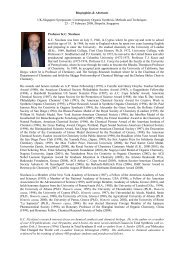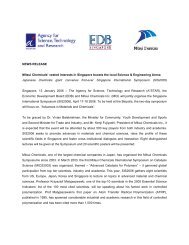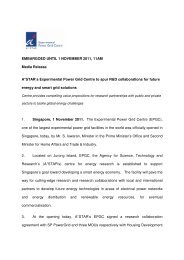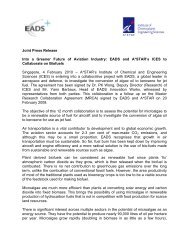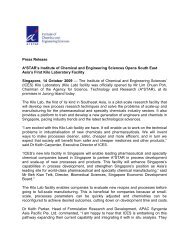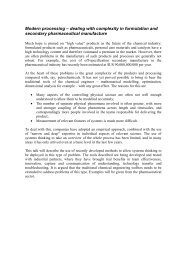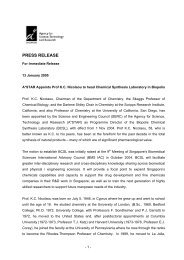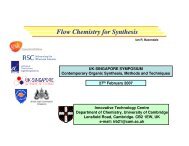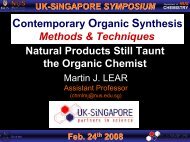here - Institute of Chemical & Engineering Sciences
here - Institute of Chemical & Engineering Sciences
here - Institute of Chemical & Engineering Sciences
You also want an ePaper? Increase the reach of your titles
YUMPU automatically turns print PDFs into web optimized ePapers that Google loves.
René H. Wijffels<br />
Pr<strong>of</strong>.dr.ir. René H. Wijffels is pr<strong>of</strong>essor in Bioprocess <strong>Engineering</strong> at<br />
Wageningen University.<br />
Since 2007 René is chairman <strong>of</strong> the Bioprocess <strong>Engineering</strong>. We work<br />
on a variety <strong>of</strong> applications:<br />
pharmaceuticals: bacterial and viral vaccines, animal cell<br />
proteins, bioactive compounds from sponges, bio-insecticides<br />
against the malaria muscito<br />
food ingredients: anti-oxidants, ω-3 fatty acids, novel food<br />
proteins<br />
bulk chemicals: butanol, biopolymers<br />
bi<strong>of</strong>uels: bioethanol and biodiesel<br />
Research<br />
Involved in more than 50 projects in the last 10 years; 5 key projects are given below:<br />
1. Photosynthetic Cell Factories. VICI grant, 2005-2010, 3 PhD students and 1 postdoc<br />
a. Development <strong>of</strong> high-efficiency photobioreactors<br />
b. Maximisation <strong>of</strong> carotenoid production<br />
c. Strain selection and milking<br />
VICI is the most prestigious research project funded by the Dutch Science Foundation (NWO)<br />
and meant is a stimulus to set up an independent research group<br />
2. Wetsus-algae. Wetsus is a collaboration <strong>of</strong> the universities <strong>of</strong> Delft, Groningen, Twente and<br />
Wageningen in the field <strong>of</strong> water technology. The total budget <strong>of</strong> this program is nearly 100 million<br />
€. Funding is based on government support and company support. In this program t<strong>here</strong> is atheme on<br />
microalgae with support from 14 companies and presently 8 PhD projects are running under this<br />
umbrella:<br />
a. Carbon dioxide supply in a photobioreactor: a biological approach<br />
b. Oxygen production in photobioreactors: a biological approach<br />
c. Harvesting <strong>of</strong> algae for oil extraction<br />
d. Biorefinery <strong>of</strong> algae: make value <strong>of</strong> protein<br />
e. An advanced study scenario approach for efficient, robust and flexible algae plants<br />
f. Maximisation <strong>of</strong> lipid productivity<br />
g. Maximisation <strong>of</strong> photosynthetic efficiency<br />
h. Post-treatment <strong>of</strong> wastewater with microalgae<br />
3. AlgaePARC. Project for infrastructure for a pilot facility. Funding from the Ministry <strong>of</strong><br />
Agriculture and th Province <strong>of</strong> Gelderland<br />
4. Towards Biosolar Cells. A collaboration between the Universities <strong>of</strong> Amsterdam, Groningen,<br />
Leiden, Delft and Wageningen) with th objective to generate fundamental research on<br />
photosynthesis in 3 areas: plants, microalgae and artificial photosynthesis. The total budget is 45<br />
miilion €. Within the algae research program t<strong>here</strong> are 4 area’s<br />
a. Utilization: 5 years support from the project and 15 companies for operation <strong>of</strong><br />
AlgaePARC<br />
b. Core program: 3 PhD projects and a postdoc project on Botryococcus<br />
c. Education: development <strong>of</strong> an international course for graduate students
Publications<br />
111 publications in peer reviewed journals; a selection <strong>of</strong> 5:<br />
Wijffels R.H., Barbosa M.J., Eppink M.H.M. (2010 Microalgae for the production <strong>of</strong> bulk<br />
chemicals and bi<strong>of</strong>uels; Bi<strong>of</strong>uels, Bioprod. Bioref. 4:287-295<br />
Wijffels R.H. , Barbosa M.J. (2010) An outlook on algal bi<strong>of</strong>uels ; Science 329:296-299<br />
Lamers P.P., Janssen M., de Vos R.C.H., Bino R.J., Wijffels R.H. (2008) Exlporing and<br />
exploiting carotenoid accumulation in Dunaliella salina for cell factory applications. Trends<br />
in Biotechnol. 26: 631-638<br />
Zijffers J.W.F., Janssen M., Tramper J., Wijffels R.H. (2008) Design process <strong>of</strong> an energy<br />
efficiënt photobioreactor. Marine Biotechnol. 10: 404-415<br />
Norsker N.H., Barbosa, M.J., Vermuë M.H., Wijffels R.H. (2010) Microalalgal production –<br />
a close look at the economics.<br />
dx.doi.org/10.1016/j.biotechadv.2010.08.005<br />
An outlook on microalgal bi<strong>of</strong>uels<br />
Rene H. Wijffels<br />
1 Wageningen University, Bioprocess <strong>Engineering</strong>, P.O. Box 8129, 6700 EV Wageningen,<br />
The Netherlands.<br />
E-mail: rene.wijffels@wur.nl; www.algae.wur.nl<br />
The feasibility <strong>of</strong> microalgae production for biodiesel and co-products will be discussed.<br />
Although algae are not yet produced at large scale for bulk applications t<strong>here</strong> are<br />
opportunities to develop this process in a sustainable way. However, it remains unlikely that<br />
the process will be developed for biodiesel as the only end product from microalgae. In order<br />
to develop a more sustainable and economically feasible process all biomass components<br />
(e.g. proteins, lipids, carbohydrates) should be used and t<strong>here</strong>fore biorefinery <strong>of</strong> microalgae is<br />
very important for the selective separation and use <strong>of</strong> the functional biomass components. If<br />
biorefinery <strong>of</strong> microalgae is applied, lipids should be fractionated into lipids for biodiesel,<br />
lipids as a feedstock for the chemical industry and ω-3 fatty acids, proteins and carbohydrates<br />
for food, feed and bulk chemicals and the oxygen produced should as well be recovered. If in<br />
addition production <strong>of</strong> algae is done on residual nutrient feedstocks and CO 2 , production <strong>of</strong><br />
microalgae at large scale against low production costs the biorefinery approach for micro<br />
algae remains feasible.<br />
In order to obtain that a number <strong>of</strong> bottlenecks need to be resolved and a multidisciplinary<br />
approach in which systems biology, metabolic modelling, strain development,<br />
photobioreactor design and operation, scale-up, biorefinery, integrated production chain and<br />
the whole system design (including logistics) should be addressed.<br />
At Wageningen UR research on microalgae involves production, metabolic modeling for<br />
accumulation <strong>of</strong> specific compounds and biorefinery. Recently pilot ptpojects started<br />
(AlgaePARC). Our research activities as well as an outlook to the future will be discussed.<br />
Wijffels R.H., Barbosa M.J. (2010) An outlook on microalgal bi<strong>of</strong>uels. Science. 379: 796-799<br />
Wijffels R.H., Barbosa M.J., Eppink M.H. (2010) Microalgae for the production <strong>of</strong><br />
bulk chemicals and bi<strong>of</strong>uels. Bi<strong>of</strong>uels, Bioproducts, & Biorefining, 4: 287-295.<br />
Norsker N.H., Barbosa M.J., Vermuë M.H., Wijffels R.H. (2010) Microalgal production – a close look at the<br />
economics. Biotechnology Advances. In press
ASANO Yasuhisa<br />
Pr<strong>of</strong>essor <strong>of</strong> the Department <strong>of</strong> Biotechnology<br />
Faculty <strong>of</strong> <strong>Engineering</strong><br />
Toyama Prefectural University, Japan<br />
+81-766-56-7500 Ext 530<br />
asano@pu-toyama.ac.jp<br />
Qualifications:<br />
Bachelor Degree: Department <strong>of</strong> Agricultural Chemistry, Faculty <strong>of</strong> Agriculture, Kyoto<br />
University, 1971-1975 (Pr<strong>of</strong>. Minoru Nakajima)<br />
Major: Pesticide Chemistry<br />
Master Degree: Department <strong>of</strong> Agricultural Chemistry, Faculty <strong>of</strong> Agriculture, Kyoto University,<br />
1975-1977 (Pr<strong>of</strong>. Koichi Ogata), Major: Applied Microbiology<br />
Ph.D. Degree: Awarded For Thesis Entitled "Microbial Degradation <strong>of</strong> Nitrile Compounds".<br />
Department <strong>of</strong> Agricultural Chemistry, Faculty <strong>of</strong> Agriculture, Kyoto University, 1977-1980<br />
(Pr<strong>of</strong>. Hideaki Yamada) , Major: Applied Microbiology<br />
Current University Appointments:<br />
Pr<strong>of</strong>essor <strong>of</strong> the Department <strong>of</strong> Biotechnology, Faculty <strong>of</strong><br />
<strong>Engineering</strong>, Toyama Prefectural University, JAPAN<br />
Current External Appointments:<br />
April 1994-Present: 1. Visiting Pr<strong>of</strong>essor <strong>of</strong> Toyama College<br />
January 1995- Present: 2. Editor, Journal <strong>of</strong> Molecular Catalysis B: Enzymatic (Elsevier)<br />
2006- Present: 3. Editor, Frontiers <strong>of</strong> <strong>Chemical</strong> <strong>Engineering</strong> in China<br />
2009-Present: 4. Chairman <strong>of</strong> Japanese Society <strong>of</strong> Enzyme <strong>Engineering</strong> 2<br />
Awards:<br />
1. Progress Award in Synthetic Organic Chemistry, Japan<br />
(1990)<br />
2. The Japan Bioscience, Biotechnology and Agrochemistry Society Award for the<br />
Encouragement <strong>of</strong> Young Scientists<br />
(1991)<br />
3. Toyama Award (1993)<br />
4. The <strong>Chemical</strong> Society <strong>of</strong> Japan Award for Technical Development for 2004 (2005)<br />
5. The Japan Bioscience, Biotechnology and Agrochemistry Society Award (The Best Award <strong>of</strong><br />
Japan Society <strong>of</strong> Bioscience, Biotechnology, and Agrochemistry) (2008)<br />
6. The Japan Bioindustry Association Award (2008)<br />
Research interests <strong>of</strong> Pr<strong>of</strong>. Yasuhisa Asano:<br />
Pr<strong>of</strong>. Asano's group in the Biotechnology Research Center <strong>of</strong> Toyama Prefectural University<br />
carries out an extensive screening for novel enzymes catalyzing new reactions, with their deep<br />
knowledge in microbiology, biochemistry, enzymology, synthetic organic chemistry, and<br />
molecular genetics, etc. They have been pioneers in the exploitation <strong>of</strong> novel enzymes, as can be<br />
seen in Pr<strong>of</strong>. Asano's discovery in 1977 <strong>of</strong> nitrile hydratase, which is now utilized in the industrial<br />
production <strong>of</strong> acrylamide (30% <strong>of</strong> world production by Mitsubishi Rayon, etc.), nicotinamide<br />
(Lonza) and 5-cyanovaleramide (Du Pont) in multi-tons scale, and in the first crystallization and<br />
characterization <strong>of</strong> phenylalanine dehydrogenase followed by its successful use in the massscreening<br />
<strong>of</strong> phenylketonuria in Japan. Not only the exploring studies, but also intensive basic<br />
studies are carried out to understand the enzymological characteristics by the use <strong>of</strong> synthetic<br />
chemicals. The structure <strong>of</strong> the enzymes are analyzed by the techniques in molecular cloning,
nucleotide and protein sequencing. Site-directed mutagenesis <strong>of</strong> the genes are routinely carried<br />
out by random and designed manners.<br />
Highlights <strong>of</strong> current work include; discovery <strong>of</strong> novel Phenylalanine dehydrogenases (PheDH)<br />
from nature, use <strong>of</strong> PheDHs in the enantioselective synthesis <strong>of</strong> natural and unnatural L amino<br />
acids; microdetermination <strong>of</strong> L-Phe in blood samples <strong>of</strong> neonates utilizing PheDH (1/3 <strong>of</strong><br />
Japanese babies are tested with the enzyme); characterization, gene cloning, structure elucidation,<br />
and X-ray structure determination <strong>of</strong> a new enzyme opine dehydrogenase as one <strong>of</strong> the first<br />
examples <strong>of</strong> D-stereospecific amino acid dehydrogenase; discovery <strong>of</strong> 3-methylaspartate<br />
ammonia lyase from facultative anaerobes for chiral synthesis and X-ray structure determination;<br />
discovery, characterization, structure determination <strong>of</strong> D-stereospecific peptidases and D-<br />
amidases and uses in the syntheses <strong>of</strong> D-amino acids and D-amino acid containing peptides;<br />
discovery and characterization <strong>of</strong> transphosphorylase producing inosine 5'-phosphate,<br />
evolutionary mutagenesis <strong>of</strong> the enzyme for industrial application (3000-6000 tons/year by<br />
Ajinomoto Co. from 2003) and X-ray structure determination, and occurrence <strong>of</strong> aldoxime<br />
dehydratase in nitrile degraders, etc.<br />
An amino acid amide racemase activity was discovered in α-amino-ε-caprolactam racemase and<br />
the dynamic kinetic resolution <strong>of</strong> amino acid amide with an amino acid amidase was realized.<br />
From 2003, a new project on protein chips using PheDH was started. Since 2003, A “multi<br />
enzyme chip” is being developed for enzyme assay system for diagnosis <strong>of</strong> phenylketonuria<br />
(PKU), galactosemia (GAL), maple syrup urine disease (MSUD) and homocystinuria (HCU),<br />
Toyama Medical Bio-Cluster Project, a MEXT project. Since 2008, Hokuriku Innovation Cluster<br />
for Health Science was started and his group is working on a new MEXT project “Development<br />
<strong>of</strong> enzyme microchips for amino acid metabolomics for detection <strong>of</strong> diseases”.<br />
They have been collaborating with Pr<strong>of</strong>. Cooper's group <strong>of</strong> Biochemistry Department at the Weill<br />
Medical College <strong>of</strong> Cornell University, USA. on the use <strong>of</strong> PheDH. They are also cooperating<br />
with Pr<strong>of</strong>s. Engel's and Mayhew's groups <strong>of</strong> Univ. College Dublin, Ireland, to explore roles <strong>of</strong><br />
some amino acid residues in PheDH and opine dehydrogenase by the site-directed mutagenesis,<br />
and the structural analyses by X-ray crystallography with Pr<strong>of</strong>. Rice's group <strong>of</strong> Univ. <strong>of</strong> Sheffield,<br />
U.K. On Aug 1, 2006, a scientific exchange agreement was made in between The Faculty <strong>of</strong><br />
Agro-Industry, Prince <strong>of</strong> Songkla University, Thailand, and the Graduate School <strong>of</strong> <strong>Engineering</strong>,<br />
Toyama Prefectural University. They and Drs. H-Kittikun and Hongpattarakere’s groups in Thai<br />
side are promoting activities in collaborative research on the development <strong>of</strong> resources <strong>of</strong> useful<br />
microorganisms and plants, and exchange <strong>of</strong> scientists and students.<br />
Their laboratory is the first one opened in the Center in 1992. Three laboratories were opened<br />
later in 1995, and the expansion <strong>of</strong> the Center was completed in 1996, when they started enrolling<br />
graduate students. Although they have 18 years <strong>of</strong> history in the Center, some <strong>of</strong> the projects<br />
were started in the Sagami <strong>Chemical</strong> Research Center, Kanagawa, Japan in 1984. Their<br />
laboratory currently consists <strong>of</strong> 1 Pr<strong>of</strong>essor, 1 Associate Pr<strong>of</strong>essor, 1 Assistant Pr<strong>of</strong>essor, 6<br />
postdoctoral fellows, 4 technicians, 3 postgraduate research students, and 13 undergraduate<br />
students. Financial supports have been provided by the Government <strong>of</strong> Toyama Prefecture, the<br />
Ministry <strong>of</strong> Education <strong>of</strong> Japan, Japan Society for the Promotion <strong>of</strong> <strong>Sciences</strong>, and various private<br />
scientific foundations and companies in Japan.<br />
Enzymatic Processes which Replaced Some <strong>of</strong> Already<br />
Established <strong>Chemical</strong> Processes<br />
Yasuhisa Asano<br />
Biotechnology Research Center and Department <strong>of</strong> Biotechnology<br />
Toyama Prefectural University, Japan
E-mail: asano@pu-toyama.ac.jp<br />
We are developing new enzyme reactions by our screening programs, and improving<br />
them by directed evolution techniques to use them in the environmentally benign chemical<br />
reactions. Not only the historical works, but also some <strong>of</strong> our recent results related to the<br />
topic will be also introduced.<br />
1. Development <strong>of</strong> enzymes in the microbial and plant “Aldoxime-Nitrile Pathway”<br />
Nitrile hydratase was discovered in Japan by the author in Kyoto University. Now nitrile<br />
hydratase-catalyzed synthesis <strong>of</strong> acrylamide is recognized as one <strong>of</strong> the world largest<br />
enzyme-catalyzed organic syntheses (it is estimated to be more than 400,000 tons/year). The<br />
process is overwhelming the one with Cu catalyst, since most <strong>of</strong> the new factories established<br />
by many companies worldwide seem to be by the enzymatic process.<br />
Aldoxime dehydratase: Aryl- and alkyl-nitriles were synthesized for the first time in high<br />
yields from the corresponding aldoximes by E. coli cells expressing a new enzyme aldoxime<br />
dehydratase, which is located upstream <strong>of</strong> the “Aldoxime-Nitrile Pathway” distributed widely<br />
among microorganisms. The structure has been solved.<br />
-Amino--caprolactam (ACL) racemase: A combination <strong>of</strong> amino acid amide hydrolases<br />
such as D-aminopeptidase, etc, and ACL racemase enables the dynamic kinetic resolution <strong>of</strong><br />
amino acid amides to form chiral amino acids. Use <strong>of</strong> other enzymes in the pathway will be<br />
also discussed. The structures <strong>of</strong> ACL racemase and D-amino acid amidase have been solved.<br />
2. A new enzymatic method <strong>of</strong> selective phosphorylation <strong>of</strong> nucleosides:<br />
We have investigated a new enzymatic nucleoside phosphorylation reaction using<br />
pyrophosphate (PPi) as a phosphate source to produce 5'-IMP with high regioselectivity.<br />
Random and rational mutageneses were successfully carried out. A novel process for<br />
producing 5'-nucleotides by a mutant enzyme has been achieved avoiding the use <strong>of</strong><br />
phosphoryl chloride, a harsh chemical. It was industrialized by Ajinomoto Co. in 2003 and<br />
the production is increasing to more than 6,600 tons/year.
Pr<strong>of</strong>essor Ribo Huang<br />
Pr<strong>of</strong>essor Ribo HUANG obtained his B.Sc degree on agriculture biology from Guangxi<br />
Agriculture University in 1982, and did his M.Sc on microbiology from 1985 to 1986 at<br />
Guangxi Agriculture University. He went to Reading University, England, to pursue his Ph.D<br />
degree on enzyme engineering and biotechnology from 1986 to 1990 (in the meantime, he<br />
worked for then British Biotechnology Limited <strong>of</strong> Oxford University for nearly two years).<br />
Pr<strong>of</strong>. Huang was awarded British ORSA Scholarship and Ph.D scholarship from BBL <strong>of</strong><br />
Oxford University during his Ph.D study (1988-1990). He worked as a pr<strong>of</strong>essor at Guangxi<br />
University from 1990-1999, and has been working as a pr<strong>of</strong>essor and a president <strong>of</strong> Guangxi<br />
Academy <strong>of</strong> <strong>Sciences</strong> since 1999 and is a highly active scientist involved in molecular<br />
enzyme technology, especially in bioenergy-related enzymes. Pr<strong>of</strong>essor Huang was awarded<br />
many national-level titles because his achievements. One important title is National<br />
Outstanding Specialists awarded by Chinese Central Government in 2006. Pr<strong>of</strong>. Huang has<br />
been authoring over 50 papers and two books. His current interest is on the application <strong>of</strong><br />
enzyme technology in biotransformation and bioenergy.<br />
Exploitation <strong>of</strong> subtropical bioresources for bioenergy in<br />
Southern China<br />
Ri-Bo Huang 1, 2<br />
1. China National <strong>Engineering</strong> Research Center for Non-Food Biorefinery (NERC-<br />
NFB); 2. China State Key Laboratory for Bioenergy & Enzyme Technology (SKL-BEET)<br />
Guangxi is a province in the Southern China, and it is full <strong>of</strong> subtropical bioresources because<br />
it accounts for 39% <strong>of</strong> China’s total subtropical area. Guangxi also shares huge similarity in<br />
many aspects <strong>of</strong> subtropical bioresources with most <strong>of</strong> ASEAN countries. Guangxi is the first<br />
province in China in mandatory adoption <strong>of</strong> E10 (10% ethanol in petrol) derived from nonfood<br />
feedstock such as sugarcane and cassava. This is regarded as very important event in<br />
China because it was implemented by Chinese Central Government, and will be seen as a<br />
pattern for the rest <strong>of</strong> China, and possibly will interest many participants from the ASEAN<br />
countries.<br />
In this presentation, following contents will be discussed: 1). The advantages <strong>of</strong> subtropical<br />
bioresources such as bagasse, cassava, rice straw, and microalgae will be presented. 2). The<br />
main research areas in my institutes including bagasse bioethanol, lignocellulosic biobutanol,<br />
biodiesel and biogas will be introduced. 3). The technological bottlenecks including<br />
pretreatment <strong>of</strong> lignocellulosic feedstock, construction <strong>of</strong> novel yeast strain capable to use C6<br />
and C5 sugars, yeast strains tolerant to ultra high (over 18% v/v) ethanol concentration, high<br />
efficient conversion and utilization <strong>of</strong> glycerol (the by-product <strong>of</strong> biodiesel processing) et al.,<br />
in fulfilling our bioenergy ambition will be discussed and our strategies to overcome these<br />
difficulties will be presented.
Guocheng DU<br />
Pr<strong>of</strong>essor in the field <strong>of</strong> food science and technology, Jiangnan University<br />
Huihe Road 170, Wuxi, Jiangsu 214036, China<br />
+86-510-85918309 (O)<br />
gcdu@jiangnan.edu.cn or kegcdu@yahoo.com.cn<br />
Education<br />
Mar., 1995-Dec., 1997 Doctor <strong>of</strong> <strong>Engineering</strong>, Department <strong>of</strong> Fermentation <strong>Engineering</strong>,<br />
Wuxi University <strong>of</strong> Light Industry, China<br />
Sept., 1987-Dec., 1989 Master <strong>of</strong> <strong>Engineering</strong>, Department <strong>of</strong> Fermentation <strong>Engineering</strong>,<br />
Wuxi University <strong>of</strong> Light Industry (the former name <strong>of</strong> Southern Yangtze<br />
University), China<br />
Sept., 1983-July, 1987 Bachelor <strong>of</strong> Food <strong>Engineering</strong>, Department <strong>of</strong> Food <strong>Engineering</strong>,<br />
Yangzhou University, Yangzhou, China<br />
Working experience<br />
Dec., 2007-present Pr<strong>of</strong>essor and Dean, School <strong>of</strong> Biotechnology, Jiangnan University, China<br />
June, 2003—Dec., 2007, Pr<strong>of</strong>essor and Vice Dean, School <strong>of</strong> Biotechnology, Jiangnan<br />
University, China<br />
July, 2003- Dec. 2004, Visiting Pr<strong>of</strong>essor in University <strong>of</strong> Hawaii, USA<br />
June, 2000-June, 2001 Post-doctoral fellow, Department <strong>of</strong> <strong>Chemical</strong> <strong>Engineering</strong>, Hong<br />
Kong University <strong>of</strong> Science and Technology, Clear Water Bay, Kowloon, Hong<br />
Kong, China<br />
Jan., 1998-June, 2000 Associate Pr<strong>of</strong>essor, School <strong>of</strong> Biotechnology, Southern Yangtze<br />
University, China<br />
Mar., 1990-Jan., 1995 Engineer and Vice General Engineer, Zhenjiang Pharmaceutical<br />
Factory, Zhenjiang, China<br />
Jan., 1998-June, 2000 Associate Pr<strong>of</strong>essor, School <strong>of</strong> Biotechnology, Southern Yangtze<br />
University, China<br />
Research Fields<br />
Metabolic engineering, Fermentation <strong>Engineering</strong>, Enzyme technology<br />
Contributing Papers<br />
More than 120 papers have been published in refereed Journals, the followings are some<br />
representative publications.<br />
1. Zhihao Wang, Yun Wang, Dongxu Zhang, Jianghua Li, Zhaozhe Hua, Guocheng Du, Jian<br />
Chen. Enhancement <strong>of</strong> cell viability and alkaline polygalacturonate lyase production by<br />
sorbitol co-feeding with methanol in Pichia pastoris fermentation. Bioresource Technology,<br />
2010, 101:1318-1323<br />
2. Jun Lin, Xianyan Liao, Guocheng Du, Jian Chen. Use <strong>of</strong> Escherichia coli add/ade mutant<br />
and Saccharomyces cerevisiae WSH2 to construct a highly efficient coupled system for<br />
glutathione production. Enzyme and Microbial Technology, 46 (2010):82–86<br />
3. Jing Zhang, Jie Liu, Zhongping Shi, Liming Liu, Jian Chen. Manipulation <strong>of</strong> B.<br />
megaterium growth for efficient 2-KLG production by K. vulgare. Process Biochemistry 45<br />
(2010) 602–606<br />
4. Zha<strong>of</strong>eng Li, Zhengbiao Gu, Miao Wang, Guocheng Du, Jing Wu and Jian Chen. Delayed<br />
supplementation <strong>of</strong> glycine enhances extracellular secretion <strong>of</strong> the recombinant α-
cyclodextrin glycosyltransferase in Escherichia coli. Appl Microbiol Biotechnol. 2010,<br />
85(3):553-561<br />
5. Bo Tang, Xianyan Liao, Dongxu Zhang, Min Li, Rong Li, Kelu Yan, Guocheng Du , Jian<br />
Chen. Enhanced production <strong>of</strong> poly(vinyl alcohol)-degrading enzymes by mixed microbial<br />
culture using 1,4-butanediol and designed fermentation strategies. Polymer Degradation and<br />
Stability 95 (2010) 557-563<br />
6. Muhammad Salman Qureshi, Dongxu Zhang, Guocheng Du, Jian Chen. Improved<br />
production <strong>of</strong> polygalacturonate lyase by combining a pH and online methanol control<br />
strategy in a two-stage induction phase with a shift in the transition phase. J Ind Microbiol<br />
Biotechnol (2010) 37:323–333<br />
7. Song Liu, Dongxu Zhang, Long Liu, Miao Wang, Guocheng Du, Jian Chen. Enhanced<br />
water absorption <strong>of</strong> wheat gluten by hydrothermal treatment followed by microbial<br />
transglutaminase reaction. Journal <strong>of</strong> the Science <strong>of</strong> Food and Agriculture, 2010, 90(4): 658-<br />
663.<br />
8. Zhiyu Liu, Dongxu Zhang, Guocheng Du, Jian Chen. Improvement <strong>of</strong> laccase production<br />
and its properties by low-energy ion implantation. Bioprocess and Biosystems <strong>Engineering</strong>.<br />
2010, 33(5): 639.<br />
9. Hejing Yan, Zhaozhe Hua, Guoshi Qian, Miao Wang. Guocheng Du, Jian Chen. Analysis<br />
<strong>of</strong> the chemical composition <strong>of</strong> Cotton Seed Coat by Fourier Transform Infrared (FT-IR)<br />
Microspectroscopy. Cellulose, 2009, 16:1099-1107<br />
10. Jun Lin, Xianyan Liao, Guocheng Du, Jian Chen. Enhancement <strong>of</strong> glutathione production<br />
in a coupled system <strong>of</strong> adenosine deaminase-deficient recombinant Escherichia coli and<br />
Saccharomyces cerevisiae. Enzyme and Microbial Technology, 2009, 44: 269–273.<br />
11. Long Liu, Jun Sun, Dongxu Zhang, Guocheng Du, Jian Chen and Wenbo Xu. Culture<br />
conditions optimization <strong>of</strong> hyaluronic acid production by Streptococcus zooepidemicus based<br />
on radial basis function neural network and quantum-behaved particle swarm optimization<br />
algorithm. Enzyme and Microbial Technology, 2009, 44(1): 24-32<br />
12. Yun Wang, Zhihao Wang, Guocheng Du, Zhaozhe Hua, Liming Liu, Jianghua. Lowering<br />
induction temperature for enhanced production <strong>of</strong> polygalacturonate lyase in recombinant<br />
Pichia pastoris. Process Biochemistry, 2009, 44 (9): 949-954<br />
13. Long Liu, Guocheng Du, Jian Chen, Miao Wang, Jun Sun. Microbial production <strong>of</strong> low<br />
molecular weight hyaluronic acid by adding hydrogen peroxide and ascorbate in batch culture<br />
<strong>of</strong> Streptococcus zooepidemicus. Bioresource Technology, 2009, 100 (1): 362<br />
14. Guobin Liang, Xianyan Liao, Guocheng Du, Jian Chen. A new strategy to enhance<br />
glutathione production by multiple.H2O2-induced oxidative stresses in Candida utilis.<br />
Bioresource Technology, 2009, 100 (1): 350-355<br />
15. Jingwen Zhou, Liming Liu, Zhongping Shi, Guocheng Du, Jian Chen. ATP in Current<br />
Biotechnology: Regulation, Application and Perspectives.<br />
Teaching activities<br />
Courses for postgraduate student include:<br />
1. “Application and Production <strong>of</strong> Environmentally Friendly Materials”.<br />
2. “Advances in Biotechnology”<br />
3. “Biochemical <strong>Engineering</strong>”
Process engineering for the biotechnological production <strong>of</strong> exopolysaccharides<br />
Guocheng Du<br />
School <strong>of</strong> Biotechnology, Jiangnan University, Wuxi, 214122, China<br />
Tel: +86-510-85918309; Fax: +86-510-85918309; E-mail: gcdu@jiangnan.edu.cn<br />
Abstract: Microbial exopolysaccharides like hyaluronic acid (HA), Kefiran and xanthan gum<br />
are rapidly emerging as a new and important source <strong>of</strong> polymeric materials. These<br />
biopolymers have novel and unique properties and already have found a wide range <strong>of</strong><br />
applications in the food, pharmaceutical and other industries. The biotechnological<br />
production <strong>of</strong> exopolysaccharides has gained considerable attention in last decades. Various<br />
process optimization strategies have been developed for the enhancement <strong>of</strong> microbial<br />
exopolysaccharides production, which is usually challenged by the low oxygen mass transfer,<br />
low energy cell status <strong>of</strong> the bacterium and the inhibition <strong>of</strong> some end-products like lactic<br />
acid. T<strong>here</strong>fore, besides the mixing performance, the cellular physiology also should be<br />
considered for the efficient microbial exopolysaccharides production.<br />
In this work, we present the process optimization approaches for the biotechnological<br />
production <strong>of</strong> HA by Streptococcus zooepidemicus and Kefiran by Lactobacillus<br />
kefiran<strong>of</strong>aciens. The mixing performance <strong>of</strong> HA production was improved via the<br />
optimization <strong>of</strong> agitation and aeration, the addition <strong>of</strong> oxygen vector n-dodecane and the<br />
reduction <strong>of</strong> broth viscosity via the HA degradation. The energy status <strong>of</strong> S. zooepidemicus<br />
was improved via the oxidative stress via the feeding <strong>of</strong> hydrogen peroxide, and the HA<br />
productivity was improved by a two-stage model based fed-batch and batch culture mode.<br />
The Kefiran productivity was improved via a process kinetics-based two-stage temperature<br />
control approach, and the inhibition <strong>of</strong> lactic acid on Kefiran production was alleviated via<br />
the co-culture <strong>of</strong> L. kefiran<strong>of</strong>aciens and Saccharomy cerevisiae.<br />
Keywords: Process optimization, Exopolysaccharide, Mixing performance, Model,<br />
Hyaluronic acid, Kefiran



